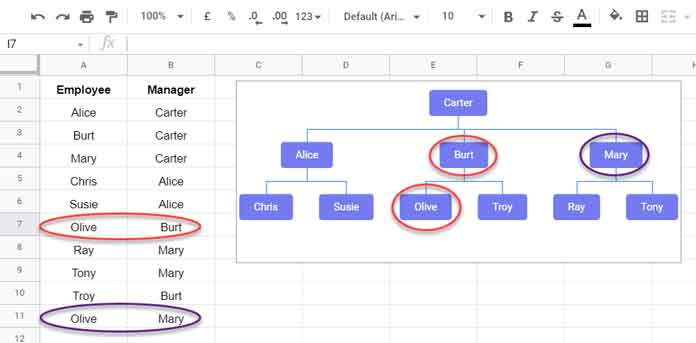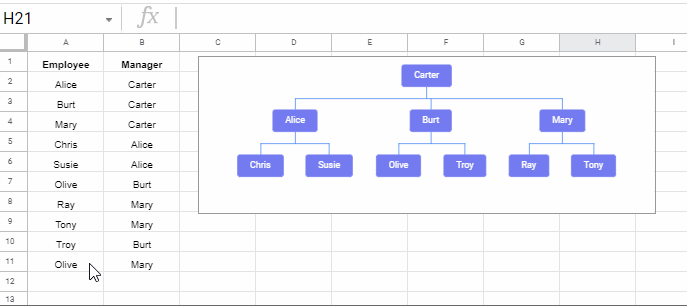Duplicates in an organizational chart refer to dual reporting, and Google Sheets’ org chart doesn’t support this without a workaround approach.
What is Dual Reporting?
Dual reporting occurs when a subordinate works under two superiors. For example, a software engineer might report to both a project manager (for project-specific tasks and deadlines) and a functional manager (for day-to-day job responsibilities).
In the case of dual reporting, Google Sheets won’t recognize the second occurrence of the subordinate when plotting the organizational chart.
Here’s an example of duplicates in an organizational chart in Google Sheets.
Example
In the following example, employee names are listed in column A, and column B holds the names of the superiors to whom the employee reports.
| Employee | Manager |
| Alice | Carter |
| Burt | Carter |
| Mary | Carter |
| Chris | Alice |
| Susie | Alice |
| Olive | Burt |
| Ray | Mary |
| Tony | Mary |
| Troy | Burt |
| Olive | Mary |
This two-column structure is the most common data format for creating an organizational chart in Google Sheets. Of course, the first column can contain employee positions, and the second column can contain superior positions instead of names.
Dual reporting occurs when multiple occurrences (duplicates) of values (names/positions) appear in the first column.
In our example, the employee “Olive” reports to both “Burt” and “Mary.” As a result, Olive’s name appears twice in column A. However, the chart only assigns Olive under Burt since it’s the first occurrence in the table.

Including Duplicates in the First Column in the Organizational Chart
First, create the chart as usual:
- Select the range A2:B11.
- Click Insert > Chart.
In the chart editor panel, select “Organizational Chart” under Chart type. Now, let’s address the duplicates in the first column of the table used to create the organizational chart.
Addressing Duplicates (Dual Reporting) in the Organizational Chart
To resolve this, double-click the cell in column A that contains the second occurrence of the employee name. Move the cursor after the last character in the name and press the spacebar once.
For example, in my sample data, you can double-click cell A11, press the spacebar once, and hit Enter. Instantly, the chart will display the name “Olive” under the manager “Mary.”

This method helps handle duplicates in the organizational chart in Google Sheets.
Logic
When you add a space, the name becomes distinct. Google Sheets treats it as a different name, thereby eliminating duplicate issues in the first column of the table.
What if a Subordinate Reports to More Than Two Managers?
To handle this, you should make all occurrences distinct by adding spaces at the end of the names in the first column of the table.
| Occurrence Number | Number of Spaces to Add |
| 1 | None |
| 2 | 1 |
| 3 | 2 |
| 4 | 3 |
This method addresses duplicates in organizational charts.
The main drawback of this workaround is that the label on the node may not be centered. However, you won’t notice any significant difference in alignment if one or two spaces are added.





















